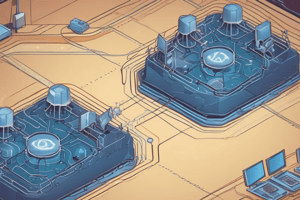Podcast
Questions and Answers
What is a primary characteristic of static routing?
What is a primary characteristic of static routing?
- It requires manual configuration and is less dynamic. (correct)
- It uses BGP to exchange routing information between networks.
- It uses the shortest path algorithm to determine routes.
- It automatically adjusts routes based on network changes.
Which dynamic routing protocol is commonly used between autonomous systems on the Internet?
Which dynamic routing protocol is commonly used between autonomous systems on the Internet?
- RIP
- BGP (correct)
- EIGRP
- OSPF
In a network using OSPF, what metric is primarily used to determine the best route?
In a network using OSPF, what metric is primarily used to determine the best route?
- Hop count
- Administrative distance
- Bandwidth (correct)
- Delay
What is the purpose of using administrative distance in route selection?
What is the purpose of using administrative distance in route selection?
In a real-world scenario, why might an organization prefer to use NAT?
In a real-world scenario, why might an organization prefer to use NAT?
What is a critical requirement for achieving high network availability?
What is a critical requirement for achieving high network availability?
Which design approach focuses on understanding business needs before selecting technologies?
Which design approach focuses on understanding business needs before selecting technologies?
What is a primary goal of failure isolation in network design?
What is a primary goal of failure isolation in network design?
What does modularity in network design aim to achieve?
What does modularity in network design aim to achieve?
What is a potential risk of overdesigning a network?
What is a potential risk of overdesigning a network?
What does the term 'failure domain' in network design refer to?
What does the term 'failure domain' in network design refer to?
What is the primary focus of a greenfield network design use case?
What is the primary focus of a greenfield network design use case?
Which security model focuses on dynamic authentication and authorization for each session?
Which security model focuses on dynamic authentication and authorization for each session?
What does the hierarchy in network design help to achieve?
What does the hierarchy in network design help to achieve?
What is the main concern when designing a solution that includes a shared fate scenario?
What is the main concern when designing a solution that includes a shared fate scenario?
Flashcards are hidden until you start studying
Study Notes
Static Routing
- Requires manual configuration of routes.
- Less dynamic compared to dynamic routing protocols.
- Does not automatically adjust routes based on network changes.
Dynamic Routing Protocols
- BGP (Border Gateway Protocol) is utilized for routing between autonomous systems on the Internet.
- It plays a critical role in how data is exchanged across different networks.
OSPF Metrics
- OSPF (Open Shortest Path First) primarily uses bandwidth as the metric to determine the best route.
- This makes it effective for optimizing data flow in the network.
Administrative Distance
- Administrative distance is used to prioritize multiple routing protocols targeting the same destination.
- It influences route selection in scenarios with overlapping routes.
NAT (Network Address Translation)
- NAT allows multiple devices within a private network to share a single public IP address.
- It enhances security and conserves the number of public IP addresses used by an organization.
Network Design Principles and Approaches
- High network availability is achieved through resiliency and redundancy to ensure continued operations during failures.
- The top-down approach prioritizes understanding business needs before selecting appropriate technologies, ensuring that solutions align with organizational goals.
Failure Management and Isolation
- The primary goal of failure isolation is to limit the impact of failures to specific areas, enhancing overall network stability.
- Techniques like failure isolation can help prevent Layer 2 broadcast storms, maintaining efficient data flow in the network.
Modularity and Scalability
- Modularity in network design involves creating purpose-built building blocks, allowing for easier upgrades and adjustments.
- Scalability ensures the network can grow and adapt as business needs evolve, supporting future expansion without major redesign efforts.
Risks and Pitfalls in Design
- Overdesigning a network can lead to increased complexity and costs, making management and operation more difficult.
- It's crucial to validate assumptions with evidence to avoid potential pitfalls in network design, ensuring decisions are based on data rather than preconceived notions.
Unstated Requirements and Best Practices
- An unstated requirement is an assumed but undocumented necessity, which can lead to oversights during implementation.
- "Gold plating" refers to the practice of overdesigning by adding unnecessary features, which can compromise project efficiency.
Security Models and Considerations
- Session- and transaction-based security employs dynamic authentication and authorization methods to enhance network security measures.
- A shared failure state describes a scenario where multiple critical services fail together, potentially causing widespread outages.
Network Layers and Functions
- The distribution layer in a hierarchical network design acts as a bridge, routing traffic between access and core layers, playing a crucial role in traffic management.
- The hierarchy in network design provides a clear separation of functions across different layers, enhancing organizational clarity and management.
Design Use Cases
- Greenfield network design focuses on building a network from scratch, which allows for the use of the latest technologies without legacy constraints.
- Brownfield network design involves integrating new technologies into existing environments, presenting unique challenges and opportunities.
Business Constraints
- A key business constraint is the time frame for project completion, which can affect resource allocation and overall strategy in network implementation.
Avoiding Common Design Pitfalls
- A common issue in network design is overlooking unique business requirements while adhering strictly to best practices, which can lead to misalignment with organizational goals.
- Understanding what constitutes a failure domain is essential; it refers to a network segment where outages can propagate, influencing recovery strategies.
Miscellaneous Concepts
- Divestment involves splitting apart a business or company network, which can complicate integration and operational continuity.
- Preconceived notions can bias network design decisions, emphasizing the need for impartial assessments based on current needs rather than historical practices.
Studying That Suits You
Use AI to generate personalized quizzes and flashcards to suit your learning preferences.




